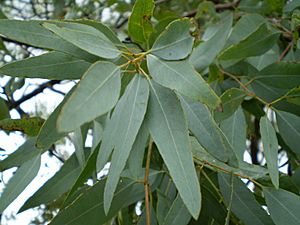Lemon-scented ironbark facts for kids
Quick facts for kids Lemon-scented ironbark |
|
|---|---|
 |
|
| Eucalyptus staigeriana leaf | |
| Scientific classification | |
| Genus: |
Eucalyptus
|
| Species: |
staigeriana
|
| Synonyms | |
|
Eucalyptus crebra var. citrata F.Muell. |
|
The lemon-scented ironbark (Eucalyptus staigeriana) is a special kind of small tree. It's an endemic tree, which means it only grows naturally in the Cape York Peninsula in Australia. This tree is easy to spot because of its rough, dark bark and its leaves, which smell like lemons when you crush them! It also has white flowers and interesting oval-shaped fruits.
Contents
What the Lemon-Scented Ironbark Looks Like
The lemon-scented ironbark is a tree that usually grows to be about 12 to 21 meters (around 40 to 70 feet) tall. It has rough, dark grey or black bark that covers its trunk and branches. This type of bark is called "ironbark" because it's very hard and strong.
Young plants have grey-green leaves that are shaped like eggs. These leaves are about 38 to 70 mm long and 20 to 40 mm wide. They also have small stems called petioles. As the tree grows, its adult leaves change. They are arranged one after another along the branch. These leaves are dull green on both sides and are shaped like a spear or an egg. They are about 40 to 110 mm long and 12 to 32 mm wide. The most interesting thing about these leaves is their strong lemon smell when you crush them!
The tree's flower buds grow in groups of seven at the ends of the branches. Each group of buds is on a main stem called a peduncle, which is about 7 to 16 mm long. Each individual bud has its own small stem, called a pedicel, about 2 to 6 mm long. The mature buds are oval or spindle-shaped, about 6 to 7 mm long and 3 to 4 mm wide. They have a cap-like cover called an operculum.
This tree blooms from December to February, and its flowers are white. After the flowers, the tree produces woody fruits. These fruits are shaped like an oval or a spindle and are about 4 to 6 mm long and 4 to 7 mm wide. They are a type of capsule, which means they open to release seeds.
How the Lemon-Scented Ironbark Got Its Name
The scientific name Eucalyptus staigeriana was first officially described in 1883. This description was made by Frederick Manson Bailey, based on notes from Ferdinand von Mueller. It was published in Bailey's book, A Synopsis of the Queensland Flora. The second part of the name, staigeriana, was chosen to honor Karl Theodore Staiger, who lived from 1833 to 1888.
Where the Lemon-Scented Ironbark Grows
The lemon-scented ironbark grows in woodlands and open forests. You can find it in hilly areas on the eastern side of the Cape York Peninsula in Australia.
Conservation Status
Good news! This type of eucalyptus tree is not considered to be in danger. The Queensland Government has classified it as "least concern" under their Nature Conservation Act 1992. This means there are plenty of these trees around.
Uses of Lemon-Scented Ironbark
The leaves of the lemon-scented ironbark are very useful! A special liquid called essential oil is taken from them. This oil has a lovely fruity-lemon smell with hints of rosemary. It's used for many things, including:
- Adding flavor to food and drinks.
- Making perfumes and other scented products.
- In aromatherapy, which uses natural plant extracts to promote well-being.
About 2.9% to 3.4% of the fresh weight of the leaves can be turned into this essential oil. The oil contains many different natural chemicals that give it its unique smell, such as geranial, limonene, and neral.
Brazil and Guatemala are the main countries that produce lemon-scented ironbark oil. Brazil alone produces up to 60 tonnes (about 66 tons) of this oil every year!
See also
 In Spanish: Corteza de hierro limón para niños
In Spanish: Corteza de hierro limón para niños

